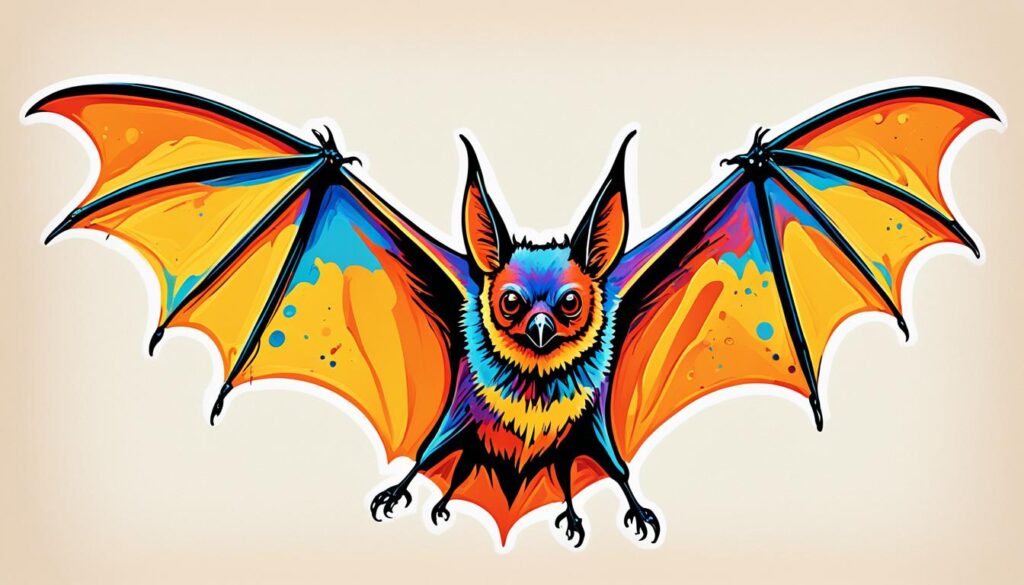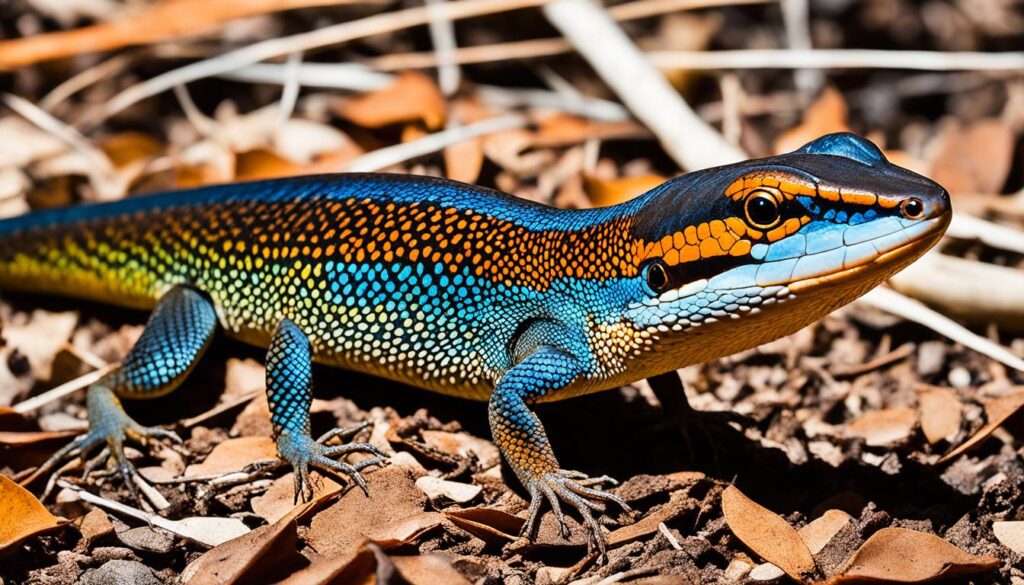Did you realize that there are many animals in nature that showcase a bright orange color? These stunning creatures can be discovered in a range of habitats, from the depths of the ocean to the canopy of the rainforest. Their bold orange shade brings a splash of splendor to the natural world, enchanting the eyes of those lucky enough to see them. Let’s explore the realm of these lively orange animals and admire their beauty in the wild.
Key Takeaways:
- Orange animals bring a vivid splash of color to the natural world.
- They can be found in diverse environments, including oceans, forests, and skies.
- Their vibrant orange hue is captivating and mesmerizing.
- Appreciating and conserving these creatures is crucial for their survival.
- Let us celebrate the beauty and importance of orange animals in our ecosystems.
Clownfish
Clownfish, known scientifically as Amphiprioninae, are a species of fish found in warm areas of the Indian Ocean where anemones can be found. They are famous for their vivid orange color and are often associated with the popular animated movie “Finding Nemo.” These fish form symbiotic relationships with sea anemones, providing mutual benefits. They have a bright orange base color marked with three black-outlined bands of white, making them easily recognizable.
| Traits | Description |
|---|---|
| Scientific Name | Amphiprioninae |
| Subfamily | Amphiprioninae |
| Color | Vivid orange with three black-outlined bands of white |
| Symbiotic Relationships | Form partnerships with sea anemones for mutual benefits |
Clownfish, with their striking orange color, are not only visually appealing but also play an important role in maintaining the health of coral reef ecosystems. Their symbiotic relationship with sea anemones provides a unique and fascinating example of nature’s interconnectedness. This relationship allows clownfish to seek refuge among the anemone’s stinging tentacles, which offer protection from predators. In return, the clownfish provide the anemone with food scraps and help to remove parasites.
Symbiotic Relationships with Sea Anemones
“The symbiotic relationship between clownfish and sea anemones is a fascinating example of mutualism in nature. Both species benefit from the partnership, with the clownfish finding protection and the anemone receiving food and parasite removal.”
The bright coloration of clownfish serves as a warning to potential predators, as their vivid orange hue is associated with toxicity. This defense mechanism helps them survive in their natural habitat, where they navigate through coral reefs and seagrass beds. Clownfish are also known for their distinct social structure, with dominant individuals called “breeders” and smaller individuals called “subordinates.”
These unique characteristics and vibrant orange color make clownfish a captivating and iconic species in the world of marine life. Their presence brings a burst of color to the underwater realm and serves as a testament to the immense beauty and diversity that nature has to offer.
Painted Bat
The painted bat, scientifically known as Kerivoula picta, is a bat species found in forested areas of India and Southeast Asia. This beautiful bat has orange fur with bright streaks of orange, resembling paint strokes. It was recently rediscovered after not being seen since 1888, making its appearance in June 2021 in Madhupur National Park. The wings of the painted bat are especially beautiful, with orange lines following the bones of the wings.

Yellow-Backed Oriole
The yellow-backed oriole, scientifically known as Icterus chrysater, is a bird species found in parts of Central America and South America. While this species is often characterized by its yellow body, some individuals have a vibrant yellowish orange color. Their black marks create a beautiful contrast with the brighter colors. The yellow-backed oriole can be found in various habitat types, including open woodlands, and feeds mostly on insects, bananas, and nectar from certain flowers.

Here is a table summarizing some key characteristics and facts about the yellow-backed oriole:
| Scientific Name | Common Name | Color | Habitat | Diet |
|---|---|---|---|---|
| Icterus chrysater | Yellow-Backed Oriole | Vibrant yellowish orange | Various habitat types, including open woodlands | Insects, bananas, and nectar from certain flowers |
Monarch Butterfly
The monarch butterfly, scientifically known as Danaus plexippus, is a widely recognized butterfly species found in North America, as well as Australia, New Zealand, and surrounding areas. It is known for its annual migration to the southern United States and Mexico, which occurs in late summer or autumn.
The monarch butterfly displays a rich tiger-orange color, with black outlines and white spots on its wings. This vibrant coloration is not only visually stunning but also serves as a warning to potential predators about its unpalatable taste. The distinct color pattern of the monarch butterfly acts as a defense mechanism, deterring predators from attacking.
The rich tiger-orange color of the monarch butterfly is a result of chemical compounds present in its wings, including pigments called pterins. These pigments, along with structural properties of the wings, create the brilliant color display.
During its annual migration, the monarch butterfly covers impressive distances, sometimes traveling thousands of miles. This incredible journey is fueled by the need to find suitable habitats for breeding and overwintering. The monarch butterfly relies on specific host plants, predominantly milkweed, for the survival of its larvae. The adult butterflies, on the other hand, sustain themselves by feeding on the nectar of various flowering plants.
To witness the awe-inspiring sight of monarch butterflies in their natural habitat is truly remarkable. Their annual migration is a testament to the resilience and adaptability of these beautiful creatures. However, it is essential to protect their habitats and conserve milkweed populations to ensure the continued survival of the monarch butterfly.

Clown Nudibranch
Discover the captivating beauty of the clown nudibranch, a vibrant creature found in warm, shallow waters. Scientifically known as Triopha catalinae, this sea slug showcases a stunning color combination of bright white with orange-tipped protrusions along its body.
The clown nudibranch is commonly found in the western Pacific, inhabiting the waters around coral reefs. Its vivid coloration serves as a natural defense mechanism, making it easily visible to divers and snorkelers.
Take a closer look at the bright white body of the clown nudibranch with its striking orange accents:

| Species | Scientific Name | Coloration | Habitat |
|---|---|---|---|
| Clown Nudibranch | Triopha catalinae | Bright white with orange-tipped protrusions | Warm, shallow waters |
As you explore the enchanting world beneath the waves, keep an eye out for the clown nudibranch. Its unique coloration and presence in warm, shallow waters make it an extraordinary sight that highlights the diversity of marine life.
Broad-Headed Skink
The broad-headed skink, scientifically known as Plestiodon laticeps, is a lizard species found in much of the southeastern United States, especially areas with live oak trees. These arboreal reptiles are known for their vivid orange to red-orange coloration, which is particularly prominent in male skinks during the mating season.
Broad-headed skinks are well-adapted to their arboreal lifestyle, spending much of their time climbing and foraging in trees. They are known for their agility and ability to navigate the branches with ease. These skinks have tapered bodies with broad, triangular heads, giving them their distinctive appearance and name.
One interesting behavior of the broad-headed skink is its choice of nesting sites. Instead of creating their own nests, they utilize pre-existing holes in live oak trees. These tree cavities provide the skinks with protection and shelter, especially during the winter months.
These lizards also possess a remarkable ability to detach their tail as a defense mechanism. When threatened by predators, such as snakes, the broad-headed skink can shed its tail, allowing it to escape while the detached tail continues to wiggle. The tail will eventually regrow, although it may not reach the same length or full coloration as the original tail.

“The broad-headed skink is a fascinating lizard species with its vivid orange to red-orange coloration, arboreal behavior, and unique nesting habits. Its ability to detach its tail as a defense mechanism showcases the remarkable strategies these reptiles employ in their natural habitats.”
Fun Facts about Broad-Headed Skinks:
- Broad-headed skinks belong to the skink family, Scincidae, which is one of the largest lizard families in the world.
- These lizards are primarily insectivorous, feeding on a variety of insects, spiders, and other small invertebrates.
- Female broad-headed skinks lay eggs, typically in late spring or early summer. The eggs are deposited in moist soil or leaf litter and hatch after an incubation period of approximately one to two months.
| Scientific Name | Common Name | Coloration | Habitat |
|---|---|---|---|
| Plestiodon laticeps | Broad-Headed Skink | Vivid Orange to Red-Orange | Arboreal, southeastern United States |
Lesser Cylinder Anemone
The lesser cylinder anemone, scientifically known as Cerianthus lloydii, is a unique sea anemone found in relatively shallow parts of the northern and eastern Atlantic. This pretty creature showcases a semi-translucent sherbet orange coloration, adding a touch of beauty to the underwater world. What makes the lesser cylinder anemone truly fascinating is its cylindrical tube home, which is buried beneath the ground. From within this tube, the anemone extends its tentacles to catch small marine animals for food. It’s a marvel of nature that captivates divers and marine enthusiasts alike.

Characteristics of the Lesser Cylinder Anemone:
| Scientific Name | Coloration | Habitat |
|---|---|---|
| Cerianthus lloydii | Semi-translucent sherbet orange | Relatively shallow parts of the northern and eastern Atlantic |
Despite its humble appearance, the lesser cylinder anemone plays a vital role in the marine ecosystem. It serves as a natural habitat and a source of food for numerous marine creatures. Additionally, its colorful presence adds vibrancy and intrigue to the underwater landscape. Observing these beautiful anemones swaying with the ocean currents is a visual treat for anyone fortunate enough to witness it.
“The lesser cylinder anemone is a stunning example of the diverse and captivating life beneath the ocean’s surface. Its pretty sherbet orange coloration and unique cylindrical tube home make it a true marvel of nature.”
Being aware of and appreciating the lesser cylinder anemone and other marine species reminds us of the importance of conservation efforts. Preserving their habitats and reducing human impact on the oceans ensures that these magnificent creatures can continue to thrive for generations to come.
Conclusion
Orange animals in nature are a true spectacle, showcasing the stunning beauty and diversity of the natural world. These vibrant creatures, with their vivid orange coloration, captivate and inspire us with their presence. From the enchanting clownfish and dazzling monarch butterflies to the elegant painted bats and intricate marbled orbweavers, these orange animals add a touch of magic to our ecosystems.
It is crucial to appreciate and conserve these magnificent creatures and their habitats. By protecting their natural environments, we ensure their survival and the preservation of our natural heritage. The conservation of these orange animals is not only about their undeniable beauty but also about maintaining a delicate balance in our ecosystems.
As we celebrate the remarkable beauty of orange animals in nature, let us also acknowledge the importance of conservation. Through our collective efforts, we can safeguard these creatures and their habitats for future generations. By promoting awareness, supporting conservation initiatives, and fostering a deep appreciation for the natural world, we can play a vital role in preserving the wonder and splendor of orange animals in nature.










